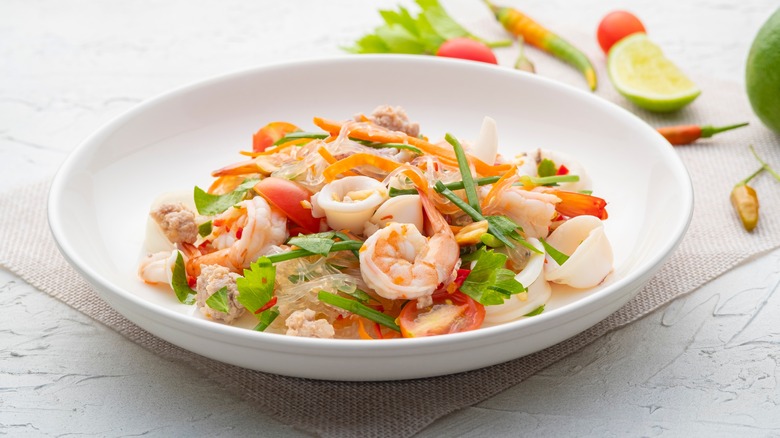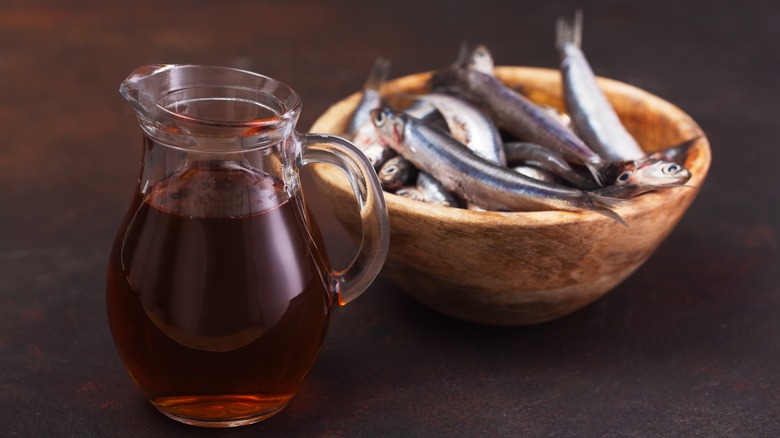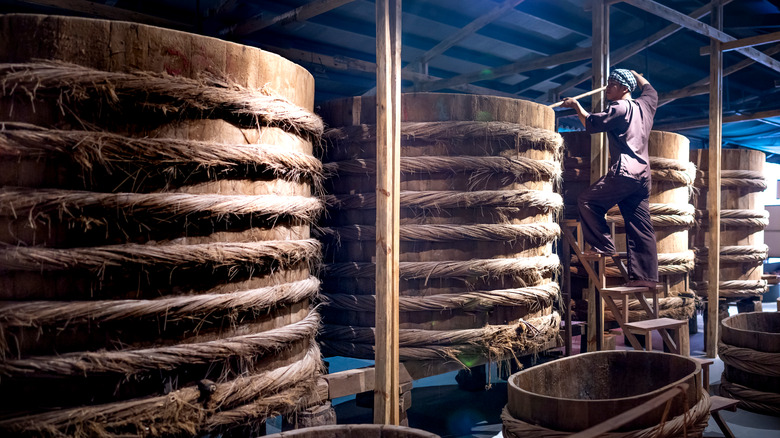What Makes Thai Salads Truly Unique?
What we call a Thai salad encompasses a wondrously wide range of culinary expression — from som tam thai, made from green papayas pounded in a wooden mortar and pestle, to sour and spicy laab moo isan, featuring poached minced pork. Each of them contains the bright, citrusy, and aromatic ingredients we associate with Thai cuisine: lime juice, fiery red chilies, sliced shallots, shredded cilantro, thinly-cut scallions — and occasionally more robust and woody characters like lemongrass and galangal. But there's one thing that is universal to all Thai salad dressings, whether they're cooked or fresh, chopped or pulverized: the ingredient known in that country as nam pla, or fish sauce.
Fish sauce is central to that uniquely South Asian culinary ability to perfectly balance assertive flavors. Thai salad dressings usually include salty and umami flavors in the form of fish sauce, sour citrus courtesy of lime juice, sweetness from white or palm sugar, and heat from one of the country's 79 varieties of spicy chili pepper, used either fresh or dried. You would think the resulting combination would taste too extreme, but a correctly made Thai salad dressing has a balanced soul, with fish sauce often being the most distinct ingredient — citrus juice, sugar, and spicy chilies, after all, appear in salads and dressings the world over.
Your next delicious salad, courtesy of ancient Greece (or is it China?)
We know that the ancient Greeks fermented a fish they called garos with salt, making a condiment they called garon. The Romans, appropriators of, well, all things, made their own fish sauce variously called garum or liquamen. Garum was on practically every Roman table, and high-quality versions of it became as prized as expensive as the best wines. Did one of the fabled "lost" Roman legions carry garum into China, where it became incorporated into Asian cuisine? It makes for a good (if colonialist) story.
It's entirely possible that nước mắm (the Vietnamese version of fish sauce) was simply adapted from Chinese soy sauce since their production methods are nearly identical. However it got there, fish sauce is integral to South Asian cuisine, and garum has even survived in the form of a condiment known as colatura di alici, which is enjoyed to this day in Southwest Italy.
You deserve the best
Since fish sauce is one of the few processed ingredients in any Thai salad (the rest will come straight from the produce and/or butcher's aisle of the grocery store), it's recommended that you get the best stuff available: The Squid and Three Crabs brands are made in Hong Kong, while Red Boat is Vietnamese. Red Boat prides itself on purity, fermenting only salted black anchovies caught off the coastal islands of Vietnam's Phú Quốc in wooden barrels.
Not all fish sauce producers are committed to such transparency and purity; in 2014, the USDA banned the import of all Thai fish sauces based on unreliable data regarding tests for botulinum. Of the nearly fifty fish sauces tested (all of which were found clear of the toxin), almost half were concluded to be "adulterated," which must mean they weren't actually made from fish. The bottom line is this: get the best fish sauce available and start exploring the bright and beautiful world of Thai salads because they're like nothing else on earth. (Oh, and maybe add a little fish sauce to your next dessert — trust us.)


